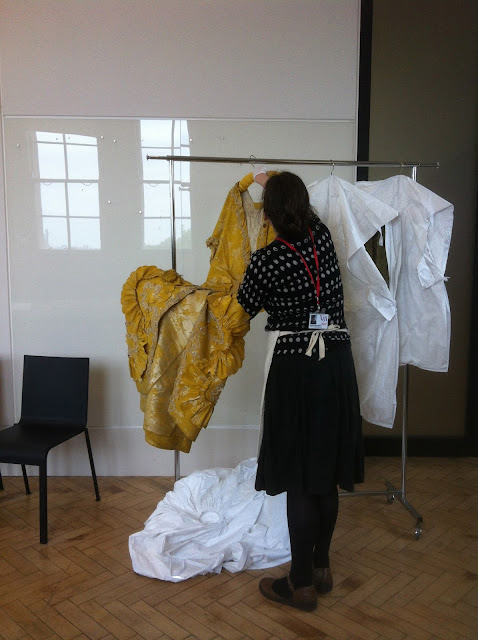The tables in the exam room had been covered entirely by the other three items I had requested, and they had actually forgotten about the sack back gown, so Sarah had to request it be brought. While we waited she packed the velvet coat and waistcoat away, so I got the opportunity to watch how its done. Mostly its about moving slowly, and being always conscious that nothing is being pulled, or twisted as its being hung up. The hangers are only used for transport, nothing is stored hanging. So when an object gets back to its proper place, the tyvek bag is opened at the top, and the hanger, removed, before it goes to its storage drawer.
In a few minutes the door opened and a rolling rack came through the door, with the two pieces of the gown each in white tyvek bags. Sarah has explained when I asked that they use tyvek exclusively now for storage, because dust and dirt can't penetrate it, its easy to clean the surface of it, and its very tough.
So, the first bag slowly gets opened and emerging like some fabulous butterfly is this incredibly brilliant yellow gown. I had chosen this particular piece because its is so perfectly the style of its time, both in structure and decoration, its like a basic textbook illustration of the period's preferences.
Sarah carefully laid it out on the table, arranging the skirts, and sleeves so they wouldn't get inadvertently crushed, and I approached. What surprised me most as I looked the gown over, was the perfection of its condition. Other than some soiling on the rear hemline, there were no stress fractures at the seams, no missing trimmings, no rips. This was the real thing, unadulterated, which was just what I wanted to see.
The gown was of English manufacture, and the figured yellow and silver silk brocade was made in Spitalfields, London; the biggest center in England for silk textile production. The decorations too were the baseline type. Everything about the Rococo style emphasized curves, so the robings, (the trimmings that go down either side of the gown's front edges) are a continuous series of ess curves. And the only other embellishment, beyond the self trims was the overlaid white silk fly fringe, which, miraculously was undamaged by time.
During this time I mentioned a famous painting by Francois Boucher of Madame de Pompadour that is, apart form its color, very similar in how its decorated. So Sarah jumped on her laptop and pulled it up to compare, as she was unfamiliar with the painting.
The last series of images here are some of Sarah packing the gown back up, so that she could lay out the underskirt for view, since that table was too small for both. And I caught a coy shot of the shoulder peeking out of its tyvek cover. Sweet, really.
So this rounds out my share about this amazing experience. Sarah, if you are reading this, my very great thanks for your patient, sweet contribution. To the Clothworker's Centre, many thanks as well. Keep doing what you do, saving these fragile, ephemeral things for us to appreciate, and learn from.









No comments:
Post a Comment